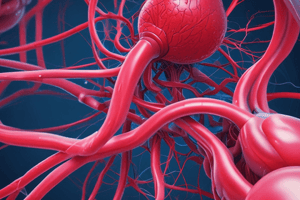Podcast
Questions and Answers
Which of the following scenarios would result in an increased cardiac output, assuming other factors remain constant?
Which of the following scenarios would result in an increased cardiac output, assuming other factors remain constant?
- An increase in both heart rate and stroke volume. (correct)
- A decrease in heart rate and an increase in stroke volume.
- An increase in afterload and a decrease in heart rate.
- A decrease in both heart rate and stroke volume.
A patient is diagnosed with hypotension. Which compensatory mechanism is most likely to be activated initially to restore blood pressure?
A patient is diagnosed with hypotension. Which compensatory mechanism is most likely to be activated initially to restore blood pressure?
- Inhibition of the renin-angiotensin-aldosterone system (RAAS) to reduce fluid retention.
- Release of natriuretic peptides to promote vasodilation.
- Increased pulmonary circulation.
- Activation of the baroreceptor reflex to increase heart rate and vasoconstriction. (correct)
According to the Starling law of the heart, what effect would an increased venous return have on cardiac output?
According to the Starling law of the heart, what effect would an increased venous return have on cardiac output?
- Increased cardiac output due to increased preload. (correct)
- No change in cardiac output.
- Decreased cardiac output due to reduced preload.
- Decreased cardiac output due to increased afterload.
If a drug blocks the conversion of angiotensin I to angiotensin II, what would be the expected effect on blood pressure and sodium excretion?
If a drug blocks the conversion of angiotensin I to angiotensin II, what would be the expected effect on blood pressure and sodium excretion?
Considering the distribution of blood in the circulatory system, a significant decrease in which compartment would most immediately compromise oxygen delivery to tissues?
Considering the distribution of blood in the circulatory system, a significant decrease in which compartment would most immediately compromise oxygen delivery to tissues?
Flashcards
Circulatory System Components
Circulatory System Components
The circulatory system consists of the heart, blood vessels (arteries, veins, capillaries), and blood.
Blood Distribution
Blood Distribution
Most blood resides in systemic circulation (84%), followed by pulmonary circulation (9%) and the heart itself (7%).
What Makes Blood Flow?
What Makes Blood Flow?
Blood flow occurs when the force driving the flow exceeds the resistance to that flow.
Cardiac Output Determinants
Cardiac Output Determinants
Signup and view all the flashcards
Determinants of Stroke Volume
Determinants of Stroke Volume
Signup and view all the flashcards
Study Notes
- The circulatory system consists of various components working together to transport blood throughout the body.
Blood Distribution
- About 9% of the total blood volume is in the pulmonary circulation.
- Around 7% of blood is within the heart itself.
- The majority, approximately 84%, circulates through the systemic circulation.
Blood Flow
- Blood flows when the force driving it exceeds the resistance it encounters.
Returning Blood to the Heart
- Understanding the mechanisms that facilitate blood return to the heart is crucial.
Determinants of Cardiac Output
- Cardiac output is determined by heart rate and stroke volume, according to the formula: Cardiac Output = Heart Rate × Stroke Volume.
Heart Rate
- Heart rate is a key factor influencing cardiac output.
Stroke Volume
- Stroke volume also plays a vital role in determining cardiac output.
Preload
- Preload affects stroke volume
Afterload
- Afterload also affects stroke volume
Starling's Law of the Heart
- Starling's law of the heart explains the relationship between preload and stroke volume.
Baroreceptor Reflex
- The baroreceptor reflex helps regulate blood pressure.
RAAS (Renin-Angiotensin-Aldosterone System)
- The RAAS system plays a significant role in blood pressure and fluid balance.
Hypotension
- Hypotension refers to low blood pressure.
Natriuretic Peptides
- Natriuretic peptides are involved in regulating blood pressure and fluid volume.
Studying That Suits You
Use AI to generate personalized quizzes and flashcards to suit your learning preferences.




